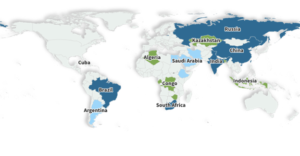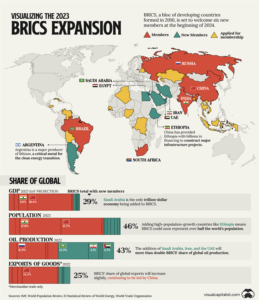Explaining the BRICS expansion.
Relevance:
- GS 2 International Relations.
- Tags: #upsc #competitiveexams #BRICS #NDB #GDP #oilproduction.
Why in the news?
- On August 24, the 15th BRICS summit in Johannesburg announced that the five-member grouping (Brazil, Russia, India, China and South Africa) had invited six new members — Iran, Saudi Arabia and the United Arab Emirates (UAE) from West Asia; Egypt and Ethiopia from Africa, and Argentina from Latin America.
About BRICS
- It has spawned two major institutions – the New Development Bank (NBD) to provide development assistance and the Contingent Reserve Arrangement that supports countries facing short-term balance-of-payments pressures.
- The NBD has already financed 96 projects valued at $33 billion.
- The headquarters of BRICS is located in
BRICS Nations and prospective countries
Argentina, Ethiopia, Egypt, Iran, Saudi Arabia, and the UAE are the six new additions to the BRICS.
How this expansion affects a few key indicators
Gross Domestic Product
- By the end of 2022, the current (and original six) members of BRICS constituted of 25.77% of the Global GDP, according to the data provided by World Bank (in current U.S. dollar prices).
- After the expansion, there are now five countries in the grouping whose GDP is over the trillion-dollar-mark.
- Post-expansion, BRICS constitutes nearly 29% of the world’s GDP.
Oil production
- Of the four metrics chosen, the BRICS grew the most in its share of oil production after its expansion.
- It grew from a per-day production share of 20.4% to 43.1%.
- Of the new members, Saudi Arabia is the biggest oil producer with 12,136 barrels per day. Saudi Arabia is followed by the United Arab Emirates, producing 4,020 barrels per day.
- Iran, along with these two countries, is among the top 10 oil-producing countries.
Exports of Goods and Services
- By the end of 2022, the original members of BRICS contributed to 18.28% of the global export of goods and services.
- With the addition of the six new economies, BRICS would now represent 20.58%.
- Out of the 12 members, China contributes as much as 12% of the global exports, with India coming in next at 2.5%.
- China’s share of global exports was 7.87% in 2009 (when BRICS was formed) and rose to 12.07% by the end of 2022.
Population
- The grouping went from having a 40.9% share of the global population to 46%. India and China are two of the world’s most populous nations. Among the new entrants, Ethiopia and Egypt have the largest populations.
- Here is a summary of how the expansion has changed the group’s position for the four metrics.
Outlook for regional and global affairs
- The new BRICS members, particularly those from West Asia, naturally fit into this political and economic framework. From 2020, both Saudi Arabia and the UAE have shrugged off the U.S. yoke and shaped independent foreign policy paths for themselves.
- Saudi Arabia has pursued de-escalation and dialogue, ending the Qatar blockade in January 2021, engaging with Turkey, and opening interactions with Iran from April 2021. These regional engagements culminated in the China-brokered accord with Iran in March this year.
- The UAE has also normalized ties with Iran and is focusing on expanding its maritime footprint across the Gulf, the Gulf of Aden, the Red Sea and the Horn of Africa.
- Iran’s entry into BRICS is propitious in that, besides its role in the energy sector, it opens up opportunities for accelerated regional economic cooperation, besides the revival of the moribund north-south connectivity projects through the Chabahar port with which India is associated.
- While Western writers continue to harp on the emerging global binary divide and the “new cold war”, India and other BRICS members reject this short-sighted view and insist on asserting their strategic autonomy in a multipolar world order, with member nations demanding that their voices be heard and their interests respected.
- It is not surprising, then, that a recent media report described the Johannesburg summit as a “turning point in modern history”.
Source: The Hindu
Mains Question
What are the challenges for India in BRICS expansion? How the BRICS is important for India and strengthening regional development in Asian economies.





